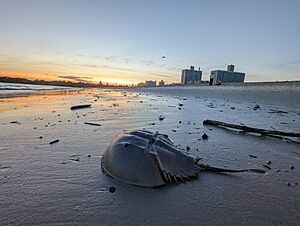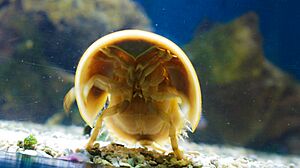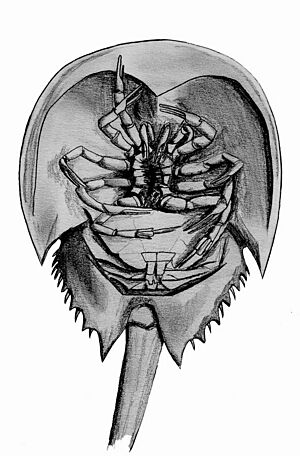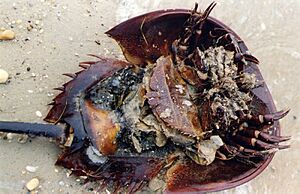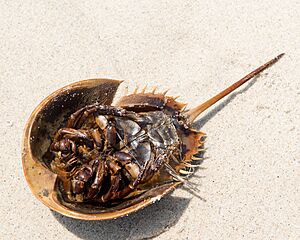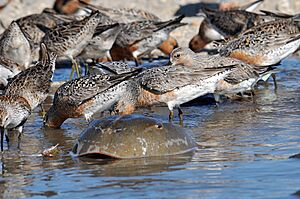Atlantic horseshoe crab facts for kids
Quick facts for kids Atlantic horseshoe crab |
|
|---|---|
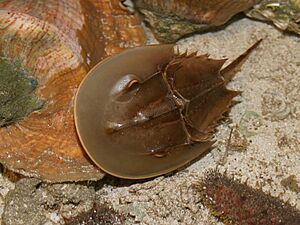 |
|
| St. Lucie County Aquarium, Florida | |
| Conservation status | |
| Scientific classification | |
| Genus: |
Limulus
|
| Species: |
polyphemus
|
| Synonyms | |
|
Monoculus polyphemus Linnaeus, 1758 |
|
The Atlantic horseshoe crab (Limulus polyphemus) is a unique sea creature. It's also called the American horseshoe crab. Even though it's called a "crab," it's actually more closely related to spiders and scorpions! These amazing animals live in the Gulf of Mexico and along the Atlantic coast of North America. A very important place for them is Delaware Bay, where many gather each year.
Horseshoe crabs are super important for their local ecosystems. Their eggs are a key food source for many shorebirds. Young and adult crabs are also eaten by sea turtles. People use Atlantic horseshoe crabs for fishing bait and in biomedicine. This means they are used in science and to make medicines.
Contents
What is a Horseshoe Crab?
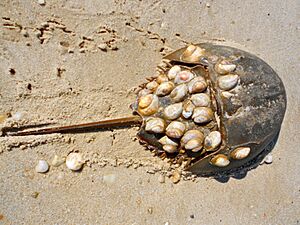
These animals have a few other nicknames, like "horsefoot" or "saucepan." Some people might even call them "helmet crabs." But that name is usually for a different kind of crab. The name "king crab" is also sometimes used, but it usually refers to a different group of crustaceans.
The scientific name Limulus means "askew." Polyphemus comes from a giant in Greek stories. This name was given because people mistakenly thought the crab had only one eye. The tail of the horseshoe crab gives its group its scientific name, Xiphosura. This means "sword tail" in Greek.
Scientists study the DNA of Atlantic horseshoe crabs. They have found different groups living in different places. While crabs from nearby areas often mix, those from the US and the Yucatán Peninsula in Mexico don't mix much. This makes some scientists wonder if they should be considered different types of crabs.
Body Parts and How They Work
Horseshoe crabs have three main body parts. These are the head area (called the "prosoma"), the middle body (called the "opisthosoma"), and the tail (called the "telson"). Their smooth shell looks like a horseshoe. It can be greenish-grey to dark brown. Females are usually bigger than males. They can grow up to 60 centimeters (24 inches) long, including their tail. They can also weigh over 4.8 kilograms (10.5 pounds).
The size of horseshoe crabs changes depending on where they live. Crabs in the middle parts of the US (like between Georgia and Cape Cod) are the largest. Those further north or south are usually smaller.
Just like many other arthropods, horseshoe crabs can regrow lost limbs. Their shells often have other sea creatures attached to them. These can include algae, flat worms, mollusks, and barnacles. Because of this, horseshoe crabs are sometimes called "walking museums"! You might often find their empty shells washed up on beaches.
The brain and heart are in the prosoma (head part). Underneath, they have six pairs of legs. The first small pair helps them put food into their mouth. Their mouth is in the middle of their underside. Horseshoe crabs don't have jaws.
The second pair of legs are called pedipalps. Males use these to hold onto the female during mating. The other four pairs of legs help them walk and push themselves along. The first four pairs have claws. The last pair has a leaf-like shape for pushing.
The opisthosoma (middle body) has six more pairs of parts. The first pair has their reproductive openings. The other five pairs are flat plates called book gills. These gills help them breathe underwater. They can also breathe on land for short times if their gills stay wet.
The telson (tail) helps them steer in the water. It also helps them flip back over if they get stuck upside down. They also have a small organ that helps them smell things in the water.
How Horseshoe Crabs See
Horseshoe crabs have been studied a lot to understand how vision works. In fact, some research on their eyes helped win a Nobel Prize in Medicine in 1967!
They have a large compound eye on each side of their head. These eyes see in black and white. They also have five simple eyes on their shell and two more simple eyes underneath, near their mouth. That's a total of nine eyes! The simple eyes are probably important when they are young embryos or larvae. Even before they hatch, they can sense light inside their eggs. As they grow, their compound eyes become their main way of seeing. Their tail also has light-sensing organs along its length.
Each compound eye has about 1000 tiny light sensors called ommatidia. These are complex structures with many cells. The nerves from these sensors are large and easy to study. This has helped scientists learn how their eyes respond to light.
Blue Blood
The blood of horseshoe crabs is very special. It contains a protein called hemocyanin, which has copper in it. This is different from human blood, which has iron in hemoglobin and is red. Horseshoe crab blood is colorless when it doesn't have oxygen. But when it touches air, it turns a dark blue! This blue blood helps them carry oxygen in their bodies.
Horseshoe crab blood also has only one type of blood cell, called amebocytes. These cells are important for fighting off germs. When they find harmful bacteria, these cells release a special substance. This substance helps their blood clot. This clotting helps to stop infections from spreading in their bodies.
Where They Live
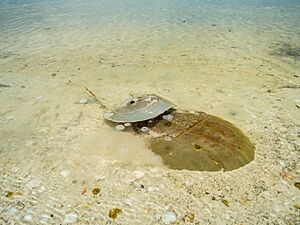
The Atlantic horseshoe crab is the only living horseshoe crab species found in the Americas. The other three living species live in Asia. All horseshoe crab species look and act quite similar.
Most Atlantic horseshoe crabs live along the Atlantic East Coast of the United States. Their range goes from Maine down to Florida. They are also found in the Gulf Coast of the United States. Outside the US, the only place they breed is in Mexico's Yucatán Peninsula. Very rarely, they might be seen in places like Canada, the Bahamas, or Cuba. People have tried to introduce them to other places like Texas, but these attempts have not worked.
Atlantic horseshoe crabs live in shallow coastal areas. These include lagoons, estuaries, and mangroves. They can also be found in deeper waters, sometimes over 200 meters (650 feet) deep. They prefer water that is less than 30 meters (100 feet) deep. They can live in water that is almost fresh or very salty. But they grow best in water that is about as salty as the ocean.
Scientists have even found very old DNA from horseshoe crabs in Greenland! This suggests that millions of years ago, when the Earth was warmer, horseshoe crabs lived much further north.
Life Cycle and Behavior
Horseshoe crabs eat mollusks, worms, and other small creatures that live on the seafloor. They also eat bits of fish. Since they don't have jaws, they use bristles on their legs to grind up their food. They also have a special stomach called a gizzard that contains sand and gravel to help with this.
Horseshoe crabs usually lay their eggs in shallow areas near the shore. They often do this during the highest tides of the month. In northern areas, they breed from spring to autumn. In southern areas, they breed all year long. In the north, warmer temperatures start the breeding season. But in the Yucatán Peninsula, cooler temperatures start it.
In places like Massachusetts, horseshoe crabs spend winters in deeper ocean waters. They come to the shoreline in late spring to lay eggs. The smaller male grabs onto the back of a female with his special front claws. He might hold on for months! Sometimes, several males will hold onto one female.
The female lays her eggs in a nest about 15-20 centimeters (6-8 inches) deep in the sand. Then, the male or males fertilize them. A female can lay anywhere from 15,000 to 64,000 eggs!
The young crabs hatch and swim for about five to seven days. Then, they settle down and shed their first shell. As they grow, they move to deeper waters and keep shedding their shells. They shed their shells about 17 times before they become adults, around age 9. Young horseshoe crabs stay in shallow waters near breeding beaches for their first few years. Most horseshoe crabs are thought to live for 20 to 40 years.
Scientists have also studied how horseshoe crabs' bodies follow a daily rhythm, like a clock. They found that horseshoe crabs have a special "clock" that controls when they move around. Light and dark cycles affect their movement, but the ocean tides have an even bigger effect!
Ancient Animals: Evolution
Horseshoe crabs are often called "living fossils." This is because they have changed very little over the last 445 million years! Animals that look almost exactly like them lived 230 million years ago. Even older similar species lived 400 million years ago. They are one of the oldest groups of sea arthropods still alive today.
The oldest known horseshoe crab fossil is about 445 million years old. It was found in Canada. It was only about 4 centimeters (1.6 inches) long.
Medical Uses
Horseshoe crabs are very important for medical research and testing. A special liquid from their blood cells is used in a test called the Limulus amebocyte lysate (LAL) test. This test helps find harmful bacteria in medicines and medical tools. It's a critical test to make sure medicines are safe for people. Scientists are also studying a protein from their blood as a possible new antibiotic.
To get the blood for the LAL test, horseshoe crabs are collected from the wild. A small amount of blood is taken from them, and then they are returned to the ocean. Most crabs survive this process. However, some crabs do not survive, and others might be a bit slower or less likely to mate afterward. Scientists are working to find ways to reduce the impact on these animals. They are trying to find new ways to test for bacteria that don't need horseshoe crab blood. They are also looking into raising horseshoe crabs in special farms.
Protecting Horseshoe Crabs
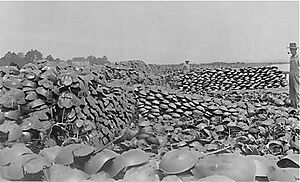
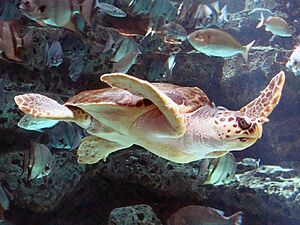
Overall, the Atlantic horseshoe crab is considered a vulnerable species. This means their numbers are decreasing in some areas. This is mainly because too many have been caught and because their homes are being lost. However, in some places, their numbers are stable or even growing.
Long ago, some people mistakenly thought horseshoe crabs harmed fishing. Because of this, some places even offered money for dead horseshoe crabs. But this was not true.
Since the 1970s, horseshoe crab numbers have dropped in some areas. This is partly because they are used as bait for catching eels and other shellfish. However, in areas where they are used for medical purposes, their populations have remained stable or grown due to protection efforts.
Conservation groups are also worried about shorebirds like red knots. These birds rely heavily on horseshoe crab eggs for food during their long migrations. When there are fewer crab eggs, these bird populations suffer. Other animals, like the Atlantic loggerhead turtle, also eat horseshoe crabs. So, fewer crabs mean less food for these turtles too.
Many efforts are being made to protect horseshoe crabs. In some states, like South Carolina, it's illegal to catch them for bait. Only hand-collecting for medical research is allowed. Groups like the Ecological Research and Development Group (ERDG) work to protect all four species of horseshoe crabs. They have even designed special bags for fishing traps. These bags help reduce the amount of crab bait needed by about half!
In 2008, a big project called Project Limulus started. It tags and counts horseshoe crabs along the North American coast. This helps scientists learn more about their populations.
Sometimes, rough waves can flip horseshoe crabs onto their backs. They often can't flip themselves back over and can die. The ERDG has a "Just Flip 'Em" campaign. They ask beachgoers to simply turn the crabs back over if they see them stuck. In New Jersey, volunteers are trained to rescue overturned crabs and collect information.
Protection in Mexico
In Mexico, the horseshoe crab populations in the Yucatán Peninsula have been protected since 1994. Their numbers have gone down since the 1960s. The remaining large groups in Mexico are mostly found in protected areas.




